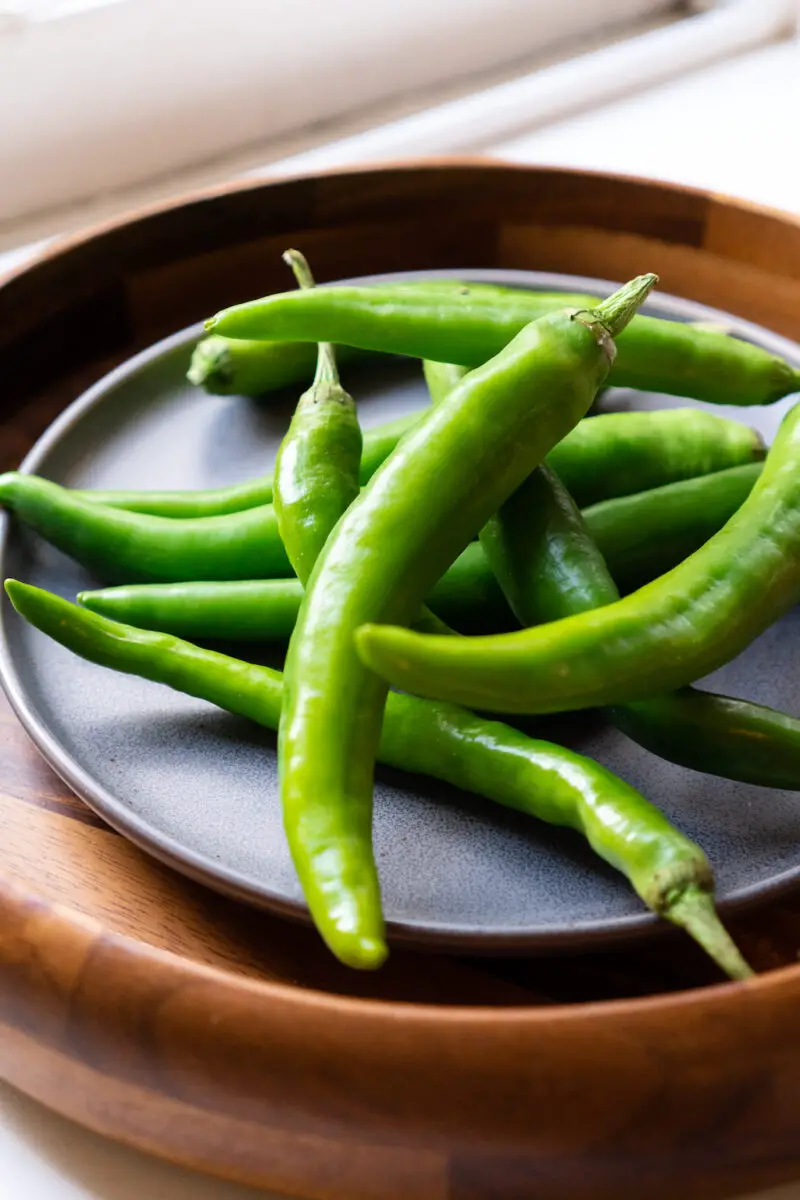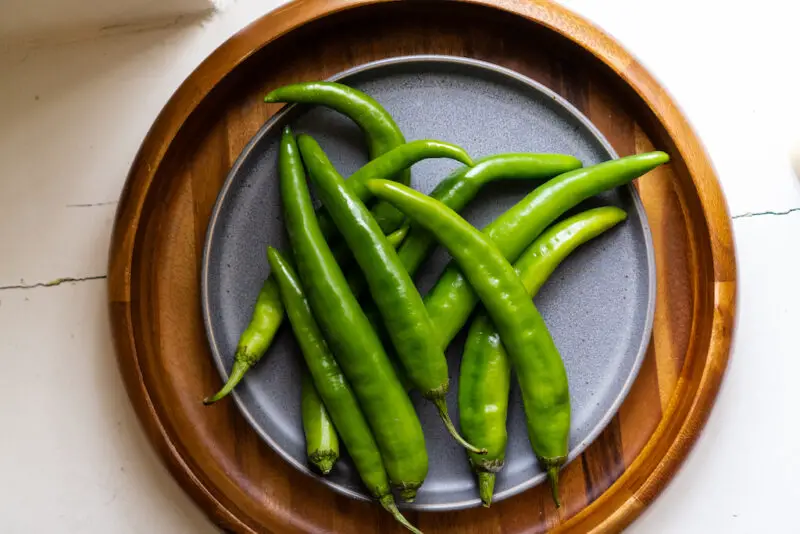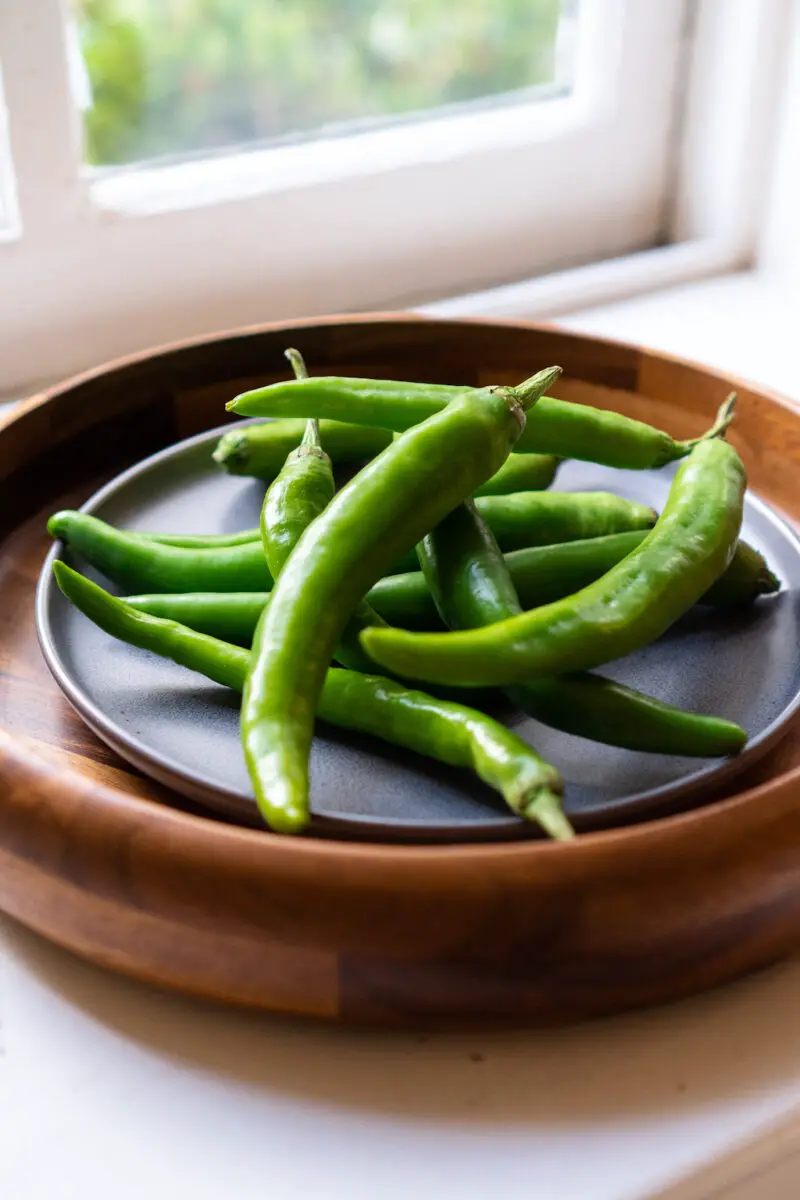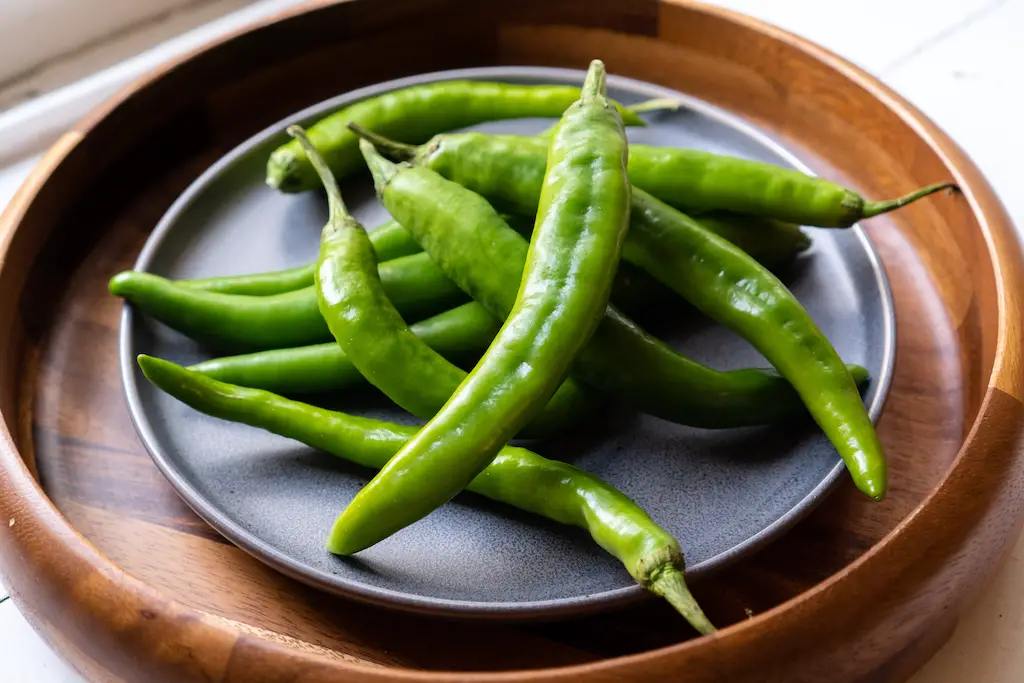This post may contain affiliate links. Please read my disclosure for details at the bottom of this page. As an Amazon Associate, I earn from qualifying purchases on this article about the Korean pepper. I hope you enjoy learning about Korean peppers, otherwise known as gochu!
Published 10/20/2022 Updated 11/09/2022
What Are Korean Peppers (Gochu)?
Korean peppers, also known as Korean hot peppers, Korean red peppers, Korean green peppers, or Korean long green peppers, are a medium-sized variety of chili peppers of the Capsicum Annuum species. The Korean chili pepper is long and slender. Typically, it has a mild, sweet flavor. The green, unripe, chili peppers measure around 1,500 Scoville heat units. As the peppers mature and redden, they get sweeter and milder.
In South Korea, the generic term for chili peppers is ‘gochu’ (고추). Below, I list the more specific terms used when discussing peppers:
- The term for the green, unripe Korean peppers is ‘put-gochu’ (풋고추).
- Then, people refer to the red, ripe peppers as ‘hong-gochu’ (홍고추).

History of Gochu in Korea:
Chili peppers are not native to South Korea. Rather, they originated from the Americas. In the late 16th century, Portuguese traders introduced chili peppers to the Korean peninsula via routes through Japan.
You can locate the first known mention of chili peppers in Korea in the Collected Essays of Jibong, an encyclopedia published in 1614. Further, you can find the next mention in a book published ca. 1700 titled Farm Management. This book discussed the cultivation methods of chili peppers as well as other produce.
Cheongyang Chili Pepper:
If you desire a spicier Korean pepper, buy the variety known as the Cheongyang chili pepper. In Korean, people refer to this pepper as ‘Cheongyang-gochu’ (청양고추).
This Korean pepper is a local specialty in the Cheongyang County of South Korea. While named the same as the region, Yoo Il-Woong named this ingredient after the Cheongsong and Yeongyang Counties when he developed the pepper in 1983. That year, he developed this chili by hybridizing the local Jejudo chili with a Thai chili. The hybridization resulted in creating a new variety with a 10,000~23,000 Scoville heat unit on average.
Like the other varieties of Korean pepper, the cheongyang-gochu is green when unripe and turns cheap red as they ripen.
Gochu in Korean Cuisine:
As stated above, in South Korea, people refer to chili peppers as ‘gochu’ (고추). Since the introduction of this ingredient on the Korean peninsula, Korean peppers have become completely ingrained in Korean culture and cuisine. Actually, you will be hard-pressed to find dishes that do not contain Korean peppers in some form!
Below, I list two popular ingredients made from Korean pepper (gochu). These two ingredients are often considered the foundation of modern and traditional Korean cuisine alongside Korean soy sauce and doenjang.
- Gochujang (고추장): In English, this fermented ingredient is known as ‘Korean red pepper paste.’ Red pepper paste is used in South Korea in stir-fries, soups, stews, and more. The base for this fermented ingredient is Korean pepper! (Learn more about this ingredient here)
- Gochugaru (고춧가루): In English, we translate ‘gochugaru’ as ‘Korean red pepper flakes’ or ‘Korean pepper powder.’ This dried spice is made from Korean pepper and, like gochujang, people use it in much of Korean cooking. (Learn more about this ingredient here)
Beyond using Korean pepper to make these two ingredients, people in South Korea use fresh peppers in soups, stews, stir-fries, kimchi, and more!

Korean Pepper Frequently Asked Questions:
Now that we learned about gochu in Korean cuisine, I want to answer some questions you may have about this ingredient! If I do not answer your question, feel free to leave a comment in the section below or email me at [email protected].
What Does Korean Pepper Taste Like? Are Korean Peppers Spicy?
While all Korean peppers have a naturally sweet flavor that deepens when the peppers ripen, the spice level differs greatly. You can buy peppers ranging from very mild to incredibly spicy. People refer to the mild Korean peppers as ‘asagi-gochu’ (아삭이고추). Then, they refer to the extremely spicy Korean peppers as ‘Cheongyang-gochu’ (청양고추), as mentioned in an above section about this variety.
Where Can I Buy This Ingredient?
While you can sometimes buy Korean peppers at your local farmers market, your best bet in finding this ingredient is at an Asian market or grocery store. You can also buy Korean pepper seeds online and grow them at home!
How Do I Properly Store Gochu?
I recommend storing your Korean peppers in a vegetable drawer in the refrigerator. Keeping the peppers in the refrigerator allows them to stay fresh longer.
What Is a Good Korean Pepper Substitute?
If you cannot find Korean peppers, I recommend using other types of pepper as a replacement. I typically use a green bell pepper when I need a sweet mild flavor. Then, I use a jalapeño, serrano, or habanero pepper when I need some spice.

I Hope You Enjoyed Learning About The Korean Pepper (Gochu)!
In the end, I hope you enjoyed learning about the uses of chili peppers in Korean cuisine. If so, let me know in the comment section!
If you would like to read more about cooking, you can find recipes as well as further Korean ingredient articles on my blog. I listed some of our favorite Carving A Journey Korean recipes below! For reference, many recipes are influenced by my family’s blended Korean and Southern heritage.
Korean Ingredient Articles:
- Garlic Chives (Buchu)
- Korean Radish (Mu)
- Abalone (Jeonbok)
- Hot Mustard in Korean Cooking (Gyeoja)
- Nuruk (Traditional Korean Starter Culture); And
- Korean Green Plum Extract (Maesil Cheong)
Further Carving A Journey Recipes:
- Korean Acorn Jelly Salad (Dotorimuk-Muchim)
- Korean Acorn Jelly (Dotorimuk)
- Korean Plum Tea (Maesil Cha)
- Korean Sausage Stir fry (Sausage Yachae Bokkeum); And
- Korean Watercress Salad (Minari Muchim)
If you have any questions or comments, you can also email me at [email protected]. And, finally, I would love to hear from you through social media as well! You can follow me at @carvingajourney on Instagram, Facebook, and Pinterest. I also started a vlog Youtube channel! Or, if you would like more articles like these, you can subscribe to my blog by joining the mailing list. Let me know if you try cooking with Korean peppers (gochu)! Thank you so much for stopping by!
Carving A Journey is a participant in the Amazon Services LLC Associates Program, an affiliate advertising program designed to provide a means for sites to earn advertising fees by advertising and linking to Amazon.com. Although we may earn commissions for our endorsement, recommendation, testimonial, and/or link to any products or services from this website, these opinions are my own and I fully support these products.

